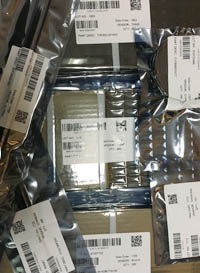| Part Number | MAX7315ATE+T |
|---|---|
| Manufacturer | Maxim Integrated |
| Description | IC I/O EXPANDER I2C 8B 16TQFN |
| Datasheet | |
| Package | 16-WFQFN Exposed Pad |
| ECAD |
|
| In Stock | 57,612 piece(s) |
| Unit Price | Request a Quote |
| Lead Time | Can Ship Immediately |
| Estimated Delivery Time | Apr 28 - May 3 (Choose Expedited Shipping) |
| Request for Quotation |
|
| Payment Methods | |
| Delivery Services |
Part Number # MAX7315ATE+T (Interface - I/O Expanders) is manufactured by Maxim Integrated and distributed by Heisener. Being one of the leading electronics distributors, we carry many kinds of electronic components from some of the world’s top class manufacturers. Their quality is guaranteed by its stringent quality control to meet all required standards.
For MAX7315ATE+T specifications/configurations, quotation, lead time, payment terms of further enquiries please have no hesitation to contact us. To process your RFQ, please add MAX7315ATE+T with quantity into BOM. Heisener.com does NOT require any registration to request a quote of MAX7315ATE+T.
Gianl*****uller
April 5, 2023
Oakl*****llison
April 4, 2023
Layt*****hhabra
March 28, 2023
Mar*****Dixon
March 20, 2023
Sut***** Orr
March 20, 2023
Santi*****uckley
March 16, 2023
Milen*****tlett
February 27, 2023
Duk*****ega
February 24, 2023
Mia*****erman
February 24, 2023





We guarantee 100% customer satisfaction.
Our experienced sales team and tech support team back our services to satisfy all our customers.

We provide 90 days warranty.
If the items you received were not in perfect quality, we would be responsible for your refund or replacement, but the items must be returned in their original condition.
| Part Number | Manufacturer | Description | Stock |
MAX7315ATE+ D# MAX7315ATE+ |
Maxim Integrated Products |
I/O Expander 16-Pin TQFN EP - Rail/Tube (Alt: MAX7315ATE+) |
0 |
MAX7315ATE+T D# MAX7315ATE+T |
Maxim Integrated Products |
I/O Expander 16-Pin TQFN EP T/R - Tape and Reel (Alt: MAX7315ATE+T) |
0 |
| Part Number | Manufacturer | Description | Stock |
MAX7315ATE+T D# MAX7315ATE+T |
Maxim Integrated Products |
I/O Expander 16-Pin TQFN EP T/R (Alt: MAX7315ATE+T) |
0 |
| Part Number | Manufacturer | Description | Stock |
MAX7315ATE+T D# MAX7315ATE+T |
Maxim Integrated Products |
I/O Expander 16-Pin TQFN EP T/R (Alt: MAX7315ATE+T) |
0 |
MAX7315ATE+ D# MAX7315ATE+ |
Maxim Integrated Products |
I/O Expander 16-Pin TQFN EP (Alt: MAX7315ATE+) |
0 |
| Part Number | Manufacturer | Description | Stock |
MAX7315ATE+T |
Maxim Integrated Products | 168 |
| Part Number | Manufacturer | Description | Stock |
MAX7315ATE+ |
Maxim Integrated Products |
Other standard logics |
100 |
MAX7315ATE-T |
Maxim Integrated Products |
I/O EXPANDER 16TQFN - Tape and Reel |
0 |
MAX7315ATE+T |
Maxim Integrated Products |
I/O EXPANDER 16TQFN - Tape and Reel |
0 |
| Part Number | Manufacturer | Description | Stock |
MAX7315ATE+ D# MAX7315ATE+-ND |
Maxim Integrated Products |
IC I/O EXPANDER I2C 8B 16TQFN |
6 |
MAX7315ATE+TG071 D# MAX7315ATE+TG071-ND |
Maxim Integrated Products |
INTEGRATED CIRCUIT |
0 |
MAX7315ATE+T D# MAX7315ATE+T-ND |
Maxim Integrated Products |
IC I/O EXPANDER I2C 8B 16TQFN |
0 |
| Part Number | Manufacturer | Description | Stock |
MAX7315ATE+T D# MAX7315ATE+T |
Maxim Integrated Products |
Industry Leading ISO:9001/AS9120A Stocking Distributor of Obsolete & Hard to Find IC's/Semi's, Specializing in Altera/Xilinx. In-House Counterfeit Detection Lab. In Business 20 Years. Free Shipping on Orders Over $250. Buy American, Buy Direct |
1661 |
| Part Number | Manufacturer | Description | Stock |
MAX7315ATE+T |
Maxim Integrated Products |
In stock shipping within 2days |
460 |
MAX7315ATE+TG071 |
Maxim Integrated Products |
In stock shipping within 2days |
28625 |
| Part Number | Manufacturer | Description | Stock |
MAX7315ATE+ D# 2516735 |
Maxim Integrated Products |
I/O EXPANDER, I2C, SMBUS, 8PORT, TQFN-16 RoHS: Compliant
Min Qty: 1
Container: Each
|
60 |
| Part Number | Manufacturer | Description | Stock |
MAX7315ATE+ |
Maxim Integrated Products |
8-Port I/O Expander with LED Intensity Control, Interrupt, and Hot-Insertion Pro RoHS: Compliant
pbFree: Yes
|
0 |
MAX7315ATE+T |
Maxim Integrated Products |
MAX7315 Series 3.6 V 400 kHz 110 uA 8-Bit I/O Surface Mount I2C-Bus - TQFN-16 RoHS: Compliant
pbFree: Yes
|
0 |
| Part Number | Manufacturer | Description | Stock |
MAX7315ATET |
Maxim Integrated Products |
OEM/CM QUOTES ONLY | NO BROKERS |
2900 |
| Part Number | Manufacturer | Description | Stock |
MAX7315ATET |
Maxim Integrated Products |
OEM/CM ONLY |
500 |
MAX7315ATETG071 |
Analog Devices Inc |
OEM/CM ONLY |
2176 |
| Part Number | Manufacturer | Description | Stock |
MAX7315ATE+TG071 |
Maxim Integrated Products |
OEM/CM Immediate delivery |
28100 |
MAX7315ATE+ |
Maxim Integrated Products |
OEM/CM Immediate delivery |
150 |
MAX7315ATE+T |
Maxim Integrated Products |
OEM/CM Immediate delivery |
100000 |
| Part Number | Manufacturer | Description | Stock |
MAX7315ATE+ D# 700-MAX7315ATE |
Maxim Integrated Products |
Interface - I/O Expanders 8-Port I/O Expander with LED Intensity Control, Interrupt, and Hot-Insertion Protection RoHS: Compliant
|
299 |
MAX7315ATE+T D# 700-MAX7315ATET |
Maxim Integrated Products |
Interface - I/O Expanders 8-Port I/O Expander with LED Intensity Control, Interrupt, and Hot-Insertion Protection RoHS: Compliant
|
1727 |
| Part Number | Manufacturer | Description | Stock |
MAX7315ATE+ D# 73Y5864 |
Maxim Integrated Products |
I/O EXPANDER, I2C, SMBUS, 8PORT, TQFN-16, Chip Configuration:-, Bus Frequency:400kHz, IC Interface Type:I2C, SMBus, Supply Voltage Min:2V, Supply Voltage Max:3.6V, Interface Case Style:TQFN, No. of Pins:16Pins, No. of I/O s:8I/O s RoHS Compliant: Yes RoHS: Compliant
Min Qty: 1
Container: Bulk
|
0 |
MAX7315ATE+T D# 73Y5865 |
Maxim Integrated Products |
I/O EXPANDER, I2C, SMBUS, 8PORT, TQFN-16, Chip Configuration:-, Bus Frequency:400kHz, IC Interface Type:I2C, SMBus, Supply Voltage Min:2V, Supply Voltage Max:3.6V, Interface Case Style:TQFN, No. of Pins:16Pins, No. of I/O s:8I/O s RoHS Compliant: Yes RoHS: Compliant
Min Qty: 1
Container: Cut Tape
|
0 |
| Part Number | Manufacturer | Description | Stock |
MAX7315ATE+T D# NS-MAX7315ATE+T |
Maxim Integrated Products |
OEM/CM ONLY |
8249 |
MAX7315ATE+ D# NS-MAX7315ATE+ |
Maxim Integrated Products |
OEM/CM ONLY |
6991 |
| Part Number | Manufacturer | Description | Stock |
MAX7315ATE+T |
Maxim Integrated Products |
OEM/CM ONLY |
791 |
MAX7315ATE+ |
Maxim Integrated Products |
OEM/CM ONLY |
3884 |
| Part Number | Manufacturer | Description | Stock |
MAX7315ATE+ |
Maxim Integrated Products |
IN stock Immediate delivery |
145 |
MAX7315ATE+T |
Maxim Integrated Products |
IN stock Immediate delivery |
99985 |
MAX7315ATE+TG071 |
Maxim Integrated Products |
IN stock Immediate delivery |
28085 |
| Part Number | Manufacturer | Description | Stock |
MAX7315ATE+T |
TAIYO YUDEN |
shipping today |
27496 |
MAX7315ATE+ |
Maxim Integrated Products |
shipping today |
196 |
| Part Number | Manufacturer | Description | Stock |
MAX7315ATE+T |
Maxim Integrated Products |
RFQ |
3646 |
MAX7315ATE-T |
Maxim Integrated Products |
RFQ |
7968 |
| Part Number | Manufacturer | Description | Stock |
MAX7315ATE+T |
Maxim Integrated Products |
IC I/O EXPANDER I2C 8B 16TQFN |
3620 |
| Part Number | Manufacturer | Description | Stock |
MAX7315ATE+ D# 2516735 |
Maxim Integrated Products |
I/O EXPANDER, I2C, SMBUS, 8PORT, TQFN-16 RoHS: Compliant
Min Qty: 1
Container: Each
|
60 |
Heisener's commitment to quality has shaped our processes for sourcing, testing, shipping, and every step in between. This foundation underlies each component we sell.

Do you have any question about MAX7315ATE+T?
+86-755-83210559 ext. 813



Scan to view this page